|
Displaying items by tag: ancient
Sicily’s regional government has set a travel ban on 23 of its most important artworks, including a painting by Caravaggio, ancient Greek sculptures, and a rare collection of Hellenistic silver.
The ban was put into effect due to growing concern that Sicily’s most treasured holdings spend too much time outside of the country, causing their own museums to suffer. Officials also stated that loans to foreign museums “have not produced benefits” for Sicily and have not occurred under “conditions of reciprocity with the borrowing institutions.” By keeping the works in Sicily, officials hope to draw more tourists to the island.
The culturally rich island of Sicily has its own regional government, which operates individually within the Italian system. Sicily’s new policies differ substantially from Italy’s more flexible lending practices.
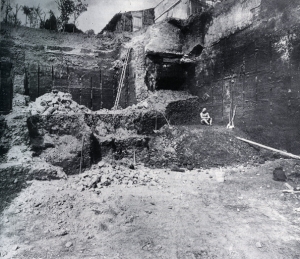
The Boxer at Rest, an ancient bronze sculpture from the Hellenistic period, is currently on view at the Metropolitan Museum of Art in New York. This is the first time the work has been exhibited outside of Europe as it typically resides at the Museo Nazionale Romano in Rome. The sculpture is on view in the Met’s Greek and Roman Galleries as part of the initiative 2013 – Year of Italian Culture in the United States, which is spearheaded by the Italian Ministry of Foreign Affairs.
The Boxer at Rest was discovered on the Quirinal Hill of Rome in 1885 and displayed alongside another Hellenistic bronze in the Rotunda of the Baths of Diocletian. The sculpture, which features a boxer in repose, is believes to be from somewhere between 350 B.C. and 50 B.C. It was made section-by-section and later welded together; it features copper inlays to depict the boxer’s wounds, drops of blood, and lips. The ancient bronze statue sits atop a modern stone base that is a close approximation of what the ancient base looked like.
The Boxer at Rest is one of very few original Greek bronze sculptures preserved from antiquity. The work will be on view at the Met through July 15, 2013.

The touring exhibition The Body Beautiful in Ancient Greece: Masterworks from the British Museum is currently on view at the Dallas Museum of Art through October 6, 2013. Presenting 120 objects from the British Museum’s renowned collection of Greek and Roman art, each work explores the human form and humanity as sources of artistic inspiration. The show spans three millennia of Greek civilization and includes marble and bronze sculptures, painted pottery, terracotta, and jewelry.
The Body Beautiful is divided into 10 thematic sections that illustrate the various ways the Greeks interpreted the human body including Cycladic figures and realistic Roman genre sculptures. Highlights from the exhibition include the Diskobolos (discus thrower) sculpture from the second century A.D., which is on view for the first time in the United States, and a model of Ancient Olympia as it would have appeared around 100 B.C. A video installation will be shown alongside the model providing glimpses of the original Olympic sites and artworks depicting the ancient athletic event.
Maxwell L. Anderson, The Eugene McDermott Director of the Dallas Museum of Art, said, “We will present a visually engaging and thought-provoking exploration of the human condition as seen by the ancient Greeks, and, equally, of the origins of our construct of beauty today.”

23 years after the notorious Isabella Stewart Gardner Museum heist took place in Boston, the FBI announced that they have identified the thieves responsible for the crime. Officials stated in a press release that the unnamed suspects are from a “criminal organization” based in the Mid-Atlantic States and New England. It is believed that some of the stolen artworks were transported to the Connecticut and Philadelphia regions, where they were offered for sale.
While the works have yet to be recovered, the FBI is reaching out to the public for helpful information and a $5 million reward is being offered for the paintings’ safe return. Today at a news conference, federal law enforcement officials announced that they will launch a comprehensive public awareness campaign that will include a dedicated FBI website, video postings on FBI social media sites, digital billboards, and a podcast.
On March 18, 1990 two thieves posing as Boston police officers entered the Isabella Stewart Gardner Museum and made off with thirteen works of art valued at $500 million. The stolen masterpieces include Johannes Vermeer’s (1632-1675) The Concert, one of only 34 known works by the artist in the world; three works by Rembrandt (1606-1669) including his only known seascape; five drawings by Edgar Degas (1834-1917); and an ancient Chinese vessel from the Shang Dynasty. The Gardner heist remains the largest private property theft ever.
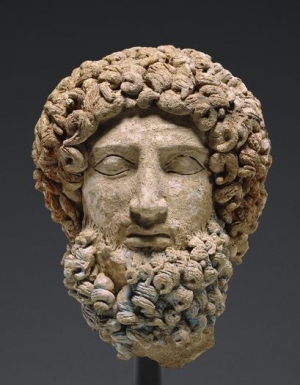
For years, Italy, Greece, and other ancient lands have accused American museums of ignoring evidence that antiquities in their collections were looted from archaeological sites. Five years ago, the Association of Art Museum Directors (AAMD) responded by making the requirements for acquiring ancient works much more stringent. The revised guidelines advised American museums against acquiring works unless solid proof existed that the artifact, prior to 1970, was outside the country where it was discovered in modern times, or was legally exported from that country after 1970.
1970 remains an important date, as it marks the year UNESCO put a stop to the illicit trafficking of antiquities. The year is now regarded as the standard cutoff for collecting. Works that appear on the market without documentation dating back that far are much more likely to have been stolen, looted, or smuggled out of their countries.
On Wednesday, January 30, 2013 the AAMD announced a few additional restrictions for American museums. The AAMD, which has 217 member museums in North America, now requires institutions to post a public explanation on the AAMD’s website if they acquire any ancient works with spotty ownership records. In addition, the museum much provide an image of the object, any known provenance information, and an explanation as to why they decided to acquire the work. If an institution fails to comply, they will be subject to ethical scrutiny and possible expulsion from the AAMD.
Officials hope that the tighter acquisition regulations will discourage American museums from obtaining questionable artifacts while supporting transparency between the United States and nations of origin who may lay claim to the antiquities.

Yale University Art Gallery will celebrate the completion of a multi-year, multi-million dollar renovation and expansion on December 12. The project cost $135 million and increased exhibition space by about one-third. The museum, which is located in New Haven, CT, now boasts nearly 70,000 square feet and includes a gallery devoted to African, Asian, and Pre-Columbian art that was designed by Louis Kahn in 1953, the Old Yale Art Gallery, which features ancient, European, and contemporary art, and the 1866 Street Hall. The project joined all three buildings to create one cohesive institution.
Besides the physical expansion, the Yale University Art Gallery has significantly increased its collection’s holdings. The museum acquired 1,100 new works including African terra-cotta figures, Greco-Roman coins, medals from the American Revolution, and marble portraits of Marcus Aurelius and Plato over 1,700 years old.
The expansion and renovation were designed and led by Duncan Hazard and Richard Olcott, partners in New York’s Ennead Architects. The project took 14 years to complete and outfitted the museum with new areas for exhibitions and object study and increased access to the Gallery’s comprehensive collections.
Four works by contemporary heavyweights Fred Tomaselli, Takashi Murakami, Mickalene Thomas, and Gilbert & George will be offered by Christie’s to benefit the artistic activities of the Brooklyn Museum. Profits from the sale, which will be held during the Post-War and Contemporary auction on November 15, will go towards the preservation and presentation of the museum’s collection, exhibitions, and a variety of public programs. The four works were made especially for the auction.
The sale marks the beginning of BKLYN: A Celebration of the Brooklyn Museum, a multi-year collaboration between Christie’s and the museum that will include additional sales benefitting the institution. Housed in a 560,000-square-foot Beaux-Arts building, the Brooklyn Museum is one of the oldest and largest institutions in the country. Its permanent collection features everything from ancient Egyptian pieces to contemporary art.
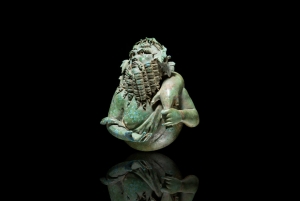
The renovated Mary and Michael Jaharis Galleries of Greek, Roman, and Byzantine Art opened to the public yesterday. The inaugural exhibition, Gods and Glamour, features 150 loans from both private collections and public institution as well as pieces from the museum’s collection. Objects such as marble sculptures, paintings, Greek pottery, jewelry, and silver come together to illustrate what life in the ancient and medieval Mediterranean world was like. A second inaugural exhibition of late Roman and early Byzantine art loaned by the British Museum is also on view through August 25, 2013.
Designed by the architectural firm, Why, the $10 million renovation was made possible by a gift from the Jaharis Family Foundation with some funds going to acquisitions and educational programs. The new 13,707 square-foot galleries include state-of-the-art display cases by Goppian Museum Workshop in Milan.
The updated Greek, Roman, and Byzantine galleries represent the final phase of the complete reinstallation of the Institute, which began in 2008 after the then new modern wing was constructed.
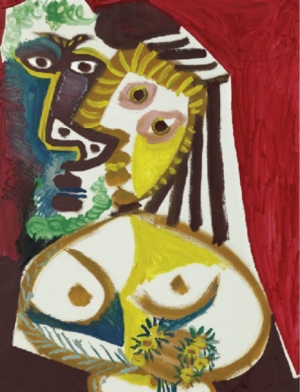
Committed to showcasing the best in contemporary art, the The Frieze Art Fair decided to mix things up in honor of its tenth anniversary. Taking place from October 11 –14, the fair will exhibit ancient works at the simultaneous inaugural show, Frieze Masters. The fair will feature 96 galleries offering works from the last 4,000 years. While the inclusion of non-contemporary work encourages crossover collecting, it also allows patrons to explore the past’s influence on contemporary art.
Between the Frieze Masters’ exhibitors and the 175 contemporary galleries participating in the fair, there will be a total of $1.5 billion worth of art in London’s Regent’s Park. After last night’s exclusive VIP preview, it seems that collectors are anxious to buy.
One of the first pieces to sell at the fete was Pablo Picasso’s Homme et Femme au Bouquet priced at $8.5 million. An unidentified U.S.-based collector snapped up the painting at Frieze Masters. Over at the contemporary fair, Paul McCartney’s 2012 mixed-media sculpture, White Snow Head, sold within the first ten minutes of the preview for $1.3 million.
Attracting thousands of visitors from around the world including big name collectors such as Martha Stewart, PPR chief executive officer Francois-Henri Pinault, and New York mayor Michael Bloomberg, it will be interesting to see the effect the fair’s widened scope will have on sales.
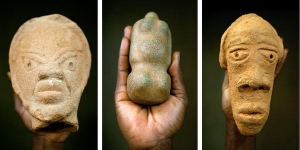
Djenne-Djenno, one of the best-known archaeological sites in sub-Saharan Africa, spreads over several acres of rutted fields near the present city of Djenne in central Mali. The ruts are partly caused by erosion, but they’re also scars from decades of digging, by archaeologists in search of history and looters looking for art to sell.
These days, with Mali in the throes of political chaos, it’s unlikely that anyone is doing much work at all at the site, though history and art are visible everywhere. Ancient pottery shards litter the ground. Here and there the mouths of large clay urns, of a kind once used for food storage or human burial, emerge from the earth’s surface, the vessels themselves still submerged.
The image of an abandoned battlefield comes to mind, but that’s only half-accurate. Physical assaults on Djenne-Djenno may be, at least temporarily, in abeyance. But ethical battles surrounding the ownership of, and right to control and dispose of, art from the past rage on in Africa, as in other parts of the world.
A few weeks ago the Museum of Fine Arts, Boston, announced the acquisition of an American private collection of 32 exquisite bronze and ivory sculptures produced in what is now Nigeria between the 13th and 16th centuries. Within days the Nigerian National Commission for Museums and Monuments claimed, via an Internet statement, that the objects had been pillaged by the British military in the late 19th century and should be given back.
More chilling were reports last month of cultural property being destroyed in Timbuktu, Mali, some 200 miles north of Djenne. Islamist groups, affiliated with Al Qaeda, have singled out Sufism, a moderate, mystical form of Islam widespread in Mali, for attack. In Timbuktu, with its Koranic schools and manuscript libraries, they have begun leveling the tombs of Sufi saints, objects of popular devotion.
In short, the wars over art as cultural property take many forms: material, political and ideological. On the surface the dynamics may seem clear cut, the good guys and bad guys easy to identify. In reality the conflicts are multifaceted, questions of innocence and guilt often — though not always — hard to nail down. In many accounts Africa is presented as the acted-upon party to the drama, the loser in the heritage fight, though such is not necessarily the case, and it certainly doesn’t have to be, and won’t be if we acknowledge Africa as the determining voice in every conversation.
|
|
|
|
|